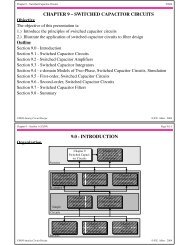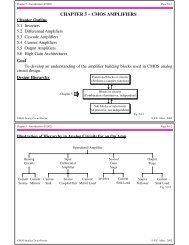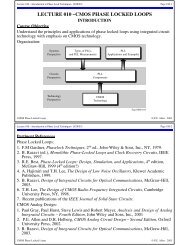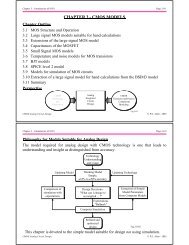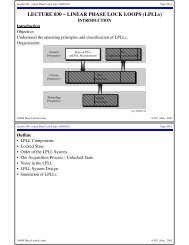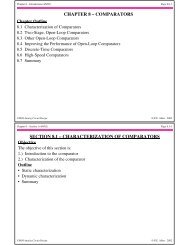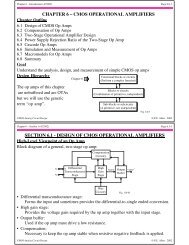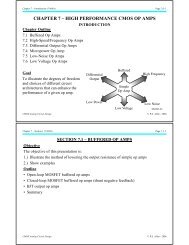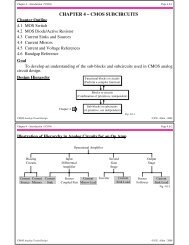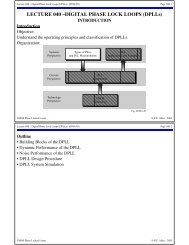You also want an ePaper? Increase the reach of your titles
YUMPU automatically turns print PDFs into web optimized ePapers that Google loves.
Chapter 6 – Section 3 (5/2/04) Page 6.3-16<br />
Example 6.3-2 - Continued<br />
It is worthwhile to check that the RHP zero has been moved on top of p 2 . To do this,<br />
first calculate the value of R z . V SG8 must first be determined. It is equal to V SG10 , which is<br />
V SG10 =<br />
2I 10<br />
K’ P S 10<br />
+ |V TP | =<br />
2·15<br />
50·1 + 0.7 = 1.474V<br />
Next determine R z .<br />
1<br />
R z = K’ P S 8 (V SG10 -|V TP |) = 106<br />
50·5.63(1.474-.7) = 4.590kΩ<br />
The location of z 1 is calculated as<br />
−1<br />
z 1 =<br />
(4.590 x 103)(3x10 -12 ) −<br />
The output pole, p 2 , is<br />
3x10 -12 = -94.46x106 rads/sec<br />
942.5x10 -6<br />
p 2 = 942.5x10 -6<br />
10x10 -12 = -94.25x10 6 rads/sec<br />
Thus, we see that for all practical purposes, the output pole is canceled by the zero<br />
that has been moved from the RHP to the LHP.<br />
The results of this design are summarized below.<br />
W 8 = 6 µm W 9 = 2 µm W 10 = 1 µm W 11 = 15 µm<br />
CMOS <strong>Analog</strong> Circuit <strong>Design</strong> © P.E. Allen - 2004<br />
Chapter 6 – Section 3 (5/2/04) Page 6.3-17<br />
An Alternate Form of Nulling Resistor<br />
To cancel p 2 ,<br />
z 1 = p 2 → R z = C c+C L 1<br />
g m6A C =<br />
C g m6B<br />
Which gives<br />
⎛<br />
⎜<br />
g m6B = g m6A⎝ ⎜<br />
C c<br />
⎞<br />
⎟<br />
⎟<br />
⎠<br />
C c +C L<br />
In the previous example,<br />
g m6A = 942.5µS, C c = 3pF<br />
and C L = 10pF.<br />
Choose I 6B = 10µA to get<br />
or<br />
g m6B = g m6AC c<br />
C c + C L<br />
→<br />
W 6B<br />
L 6B<br />
⎛<br />
= ⎜<br />
⎝<br />
3 ⎞<br />
⎟<br />
⎠<br />
I 13 2 6A W 6A<br />
I 6B<br />
L 6A<br />
⎛<br />
= ⎜<br />
⎝<br />
2K P W 6B I 6B<br />
L 6B<br />
- M1 M2<br />
v in<br />
+<br />
+<br />
VBias<br />
-<br />
M3<br />
M4<br />
M5<br />
V DD<br />
M11<br />
M6B<br />
M8<br />
V SS<br />
M10<br />
C c<br />
M9<br />
M6<br />
v out<br />
C L<br />
M7<br />
Fig. 6.3-4A<br />
3 ⎞<br />
⎟<br />
13 2 ⎛<br />
⎜<br />
⎠ ⎝<br />
⎟<br />
⎠<br />
⎛<br />
= ⎜<br />
⎝<br />
C c<br />
C c +C L<br />
⎞<br />
⎟<br />
⎠<br />
2K P W 6A I D6<br />
L 6A<br />
95⎞<br />
10 (94) = 47.6 → W 6B = 48µm<br />
CMOS <strong>Analog</strong> Circuit <strong>Design</strong> © P.E. Allen - 2004




